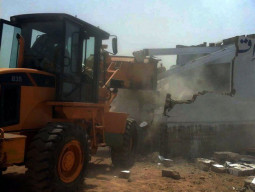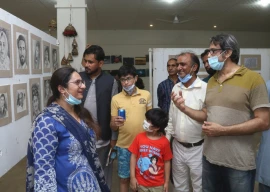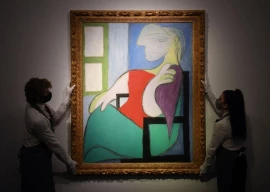
The refinement of painting techniques as practiced in Mughal ateliers is on glorious display in S M Khayyam's fine miniature artwork currently showing at Chawkandi Art. Titled 'Certainty', the 15 works invite contemplation on beauty, impermanence and ephemerality.
Khayyam works strictly in the techniques of Mughal miniature painting particularly as it evolved under the reigns of Jahangir and Shah Jahan. An active patron of the arts like his father Akbar, Jahangir established an atelier in Allahabad. He brought a trend towards modernity by favouring the hand of a single artist for an artwork rather than the collaborative production as was common in Akbar's ateliers. Under Shah Jahan, formal portraiture and courtly scenes acquired prominence.
Khayyam's work is luminous with color. He incorporates pure pigments and metals such as lapis lazuli and turquoise, cochineal and onyx, and gold leaf, which he burnishes to a high degree. Portraiture, text and still life are all featured in the content. As a modern miniaturist, Khayyam has synthesised imagery from a range of works across different periods of Islamic miniature painting.
'Shah Jahan I' (2021) is a life-size portrait of the emperor, painted in profile. A golden halo surrounds his head. His rose-pink embroidered tunic is set off with an actual necklace made with pearls, rubies and emeralds. This unusual addition addsa 3-D feature to the flatness of the painting. Other characters from Mughal history also inhabit Khayyam's artwork. There are full-figure representations of Dara Shikoh and Jahanara, Zeb-un-Nisa and Mumtaz Mahal. Some figures are painted monochromatically in the manner of a shaded drawing.
Read More: Aspiring artists showcase miniature paintings
A variety of framing styles is used for the paintings; some ornate floral hash'iya borders and others plainer and more ragged. These ragged edges are clues to the philosophical ideas embedded in the artwork, as is the treatment of the portraits. Whereas the costumes are painted with sharp and brilliant color, the faces are deliberately dulled by layers of translucent skin tones. Khayyam plays with notions of certainty and uncertainty with these clues. The slightly opaque rendering of faces hint at the mortality of life. Similarly, the ragged frames suggest that the glories of history are subject to decay.
The ascetic notion of transience is strongly underscored by these visual dynamics. Once this dynamic is brought to our conscious thoughts, the vibrant colors of the paintings also become suggestive of the ephemeral and transient. A wistful nostalgia is evoked by the thought that great beauty is vulnerable to loss.
In addition to the figurative work, Khayyam has created a painting with pure text. This untitled artwork on linen, with lapis lazuli and gold leaf, depicts Kufic writing in the manner of the rare Blue Quran manuscript. The text is a couplet from Hairat Allahabadi's ghazal:
Agah apni maut se koi basharnahin/ No one can foresee the time of death
Saman saubaras ka hai pal ki khabar nahin/ We plan for a century not knowing if we will draw our next breath
This cautionary message that contrasts the unpredictability of death with our certainty in the longevity of plans. Even the sumptuous Shah Jahan painting contains the following line (in Kufic script) composed by Khayyam himself:
Matti ne matti main matti ho jana/ All will return to earth.
Thus, similar themes can be expressed very differently according to cultural tropes. Artists like Khayyam are keeping the legacy of generations of painters from the Muslim world alive by faithfully adhering to their aesthetic virtuosity yet presenting new ideas with continuing relevance to our lives. As we reflect upon the messages in Khayyam's art, we cannot doubt thatart offers profound reflections on the nature of time and existence.
Published in The Express Tribune, March 15th, 2022.



1719660634-1/BeFunky-collage-nicole-(1)1719660634-1-165x106.webp)

1732276540-0/kim-(10)1732276540-0-165x106.webp)















COMMENTS
Comments are moderated and generally will be posted if they are on-topic and not abusive.
For more information, please see our Comments FAQ